How to model efficiently using existing 2D and 3D sources
Table of Contents
Introduction
Now that you have a basic understanding of SketchUp, you need to decide how SketchUp fits into the framework of design in your office. By its non-procedural nature, SketchUp does not require a certain series of steps to accomplish a given task. As you progress in your use of the software, you may find that you use several different methods to accomplish a recurring task, depending upon the context of the current model. This is good, and is as it should be. We do not proscribe a particular methodology or work flow.
An introduction to using different source material for modeling
There are several workflows that can be identified as common to building product manufacturers. We have produced several videos which make it easier to explain them, and they are linked below. Existing CAD models provide very accurate geometry which makes over-modeling improvements in SketchUp far easier and quicker, using the CAD model for reference while placing new geometry. Over-modeling refers to either trace-over modeling or model optimization.
Trace-over modeling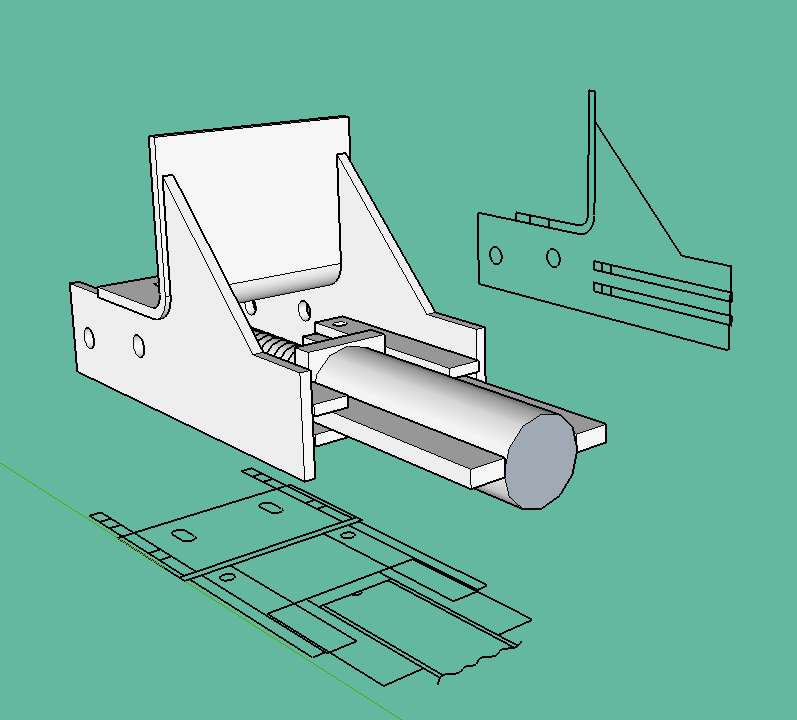 There are two types of trace-over modeling workflows based upon the CAD input used. One is from 2D CAD files, the other is when you use scanned images such as PNG, JPG, and PDF.
There are two types of trace-over modeling workflows based upon the CAD input used. One is from 2D CAD files, the other is when you use scanned images such as PNG, JPG, and PDF.
When working from 2D CAD linework, keep the CAD import as a component which you will use for reference when trace-over modeling.
 You can also model from an image file. This is usually based upon traditional CAD output, which contains several 2D views of plan, sections, and elevations of the item.
You can also model from an image file. This is usually based upon traditional CAD output, which contains several 2D views of plan, sections, and elevations of the item.
Modeling from photos
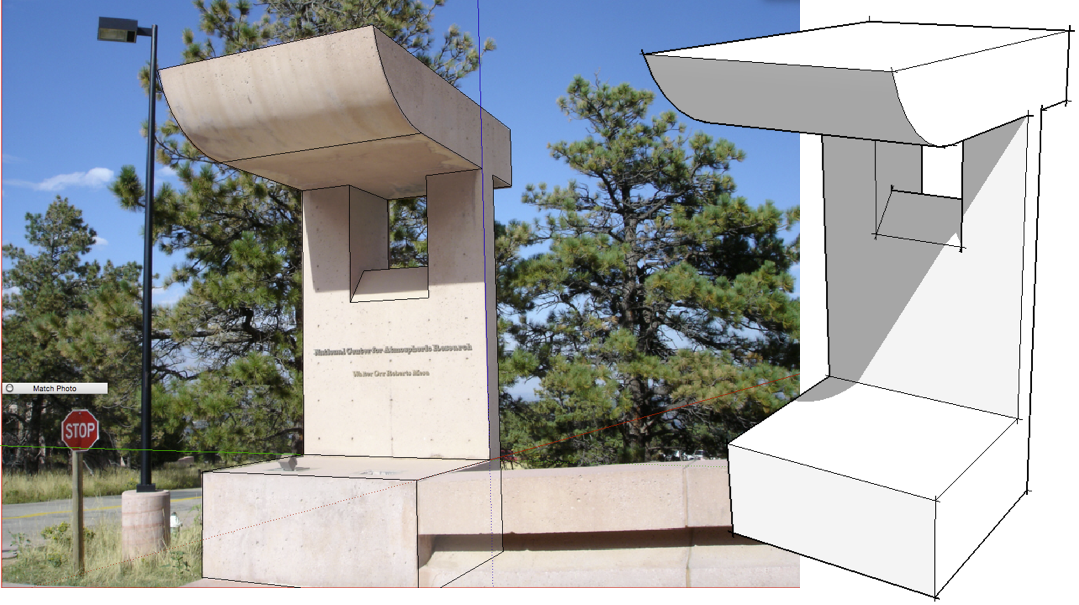 You can also model from a photo of a product. This is a very advanced technique and requires great care when setting up the model in the first place. It lends itself better to angular forms, although it can be used effectively to apply photo textures to more organic forms.
You can also model from a photo of a product. This is a very advanced technique and requires great care when setting up the model in the first place. It lends itself better to angular forms, although it can be used effectively to apply photo textures to more organic forms.
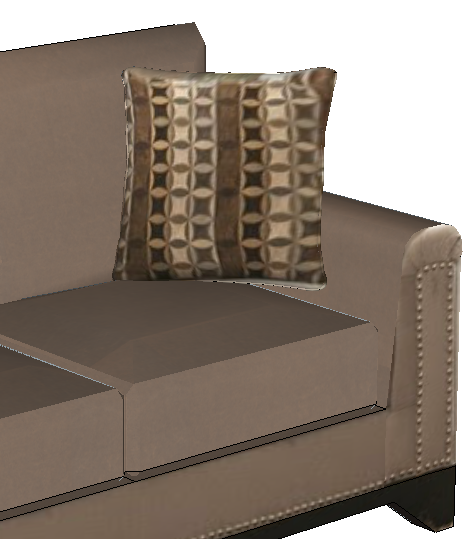 You can tweak a photograph and use it as a projected texture onto a 3D model to achieve good graphic results. This enables you to add realistic visual detail to areas of the model without adding to the polygon count.
You can tweak a photograph and use it as a projected texture onto a 3D model to achieve good graphic results. This enables you to add realistic visual detail to areas of the model without adding to the polygon count.
Here, the photo adds all the buttons along the arm of the chair, without having to model each button. The cushion uses one image across a smooth surface, rather than modeling each area of color.
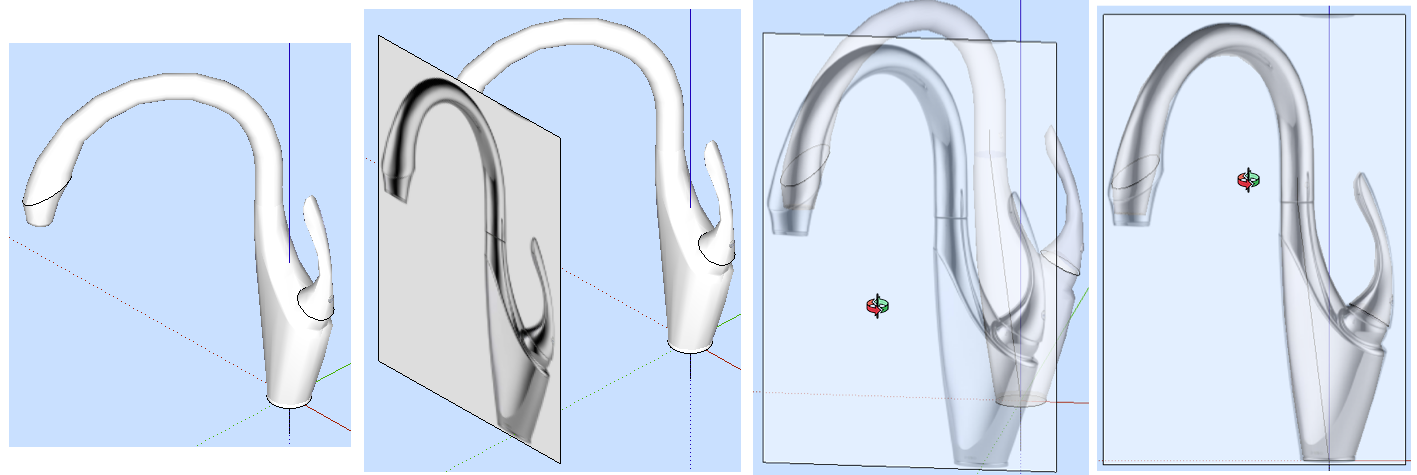
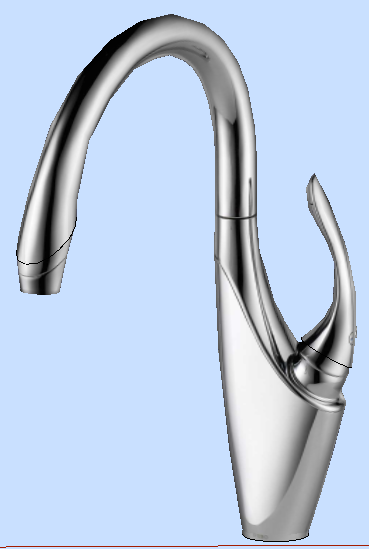
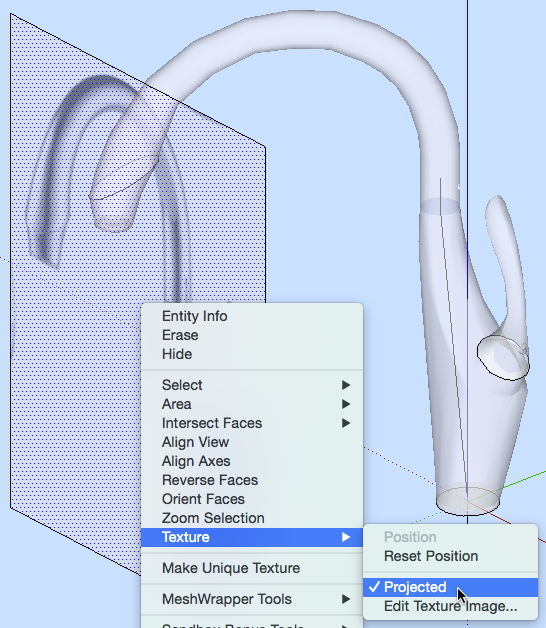 This example shows how to add a picture of a faucet to a 3D model of the faucet. Paint a face with the picture as a texture. Orient the painted face to the model (using X-ray mode in SketchUp). Right click [context click] on the face and select Texture > Projected. Then sample the paint, and paint it onto the model geometry.
This example shows how to add a picture of a faucet to a 3D model of the faucet. Paint a face with the picture as a texture. Orient the painted face to the model (using X-ray mode in SketchUp). Right click [context click] on the face and select Texture > Projected. Then sample the paint, and paint it onto the model geometry.
Importing CAD files
Before importing a CAD fileMake sure there is at least one element or line in your model prior to CAD import (even a single line will suffice). This will import the CAD file as a single component, with its linework isolated from the rest of the model. Watch this video of importing CAD files into SketchUp for the import file types DWG/DXF, STL, 3DS, and IFC.
Steps when importing CAD files- Optional: Prep the CAD file for SketchUp import.
- Run very large 3D files (larger than 20Mb) through a poly reducer to make modeling in SketchUp more responsive. If possible specify the granularity of the triangle export.
- For 2D files, export multiple CAD files limiting layers as appropriate in each to manage clutter when in SketchUp. Specifically turn off all text and dimensions and their leader lines so that they do not import as linework.
- File > Import, and set drawing units, and decide whether to preserve the drawing origin.
- Group the import geometry.
- If any geometry exists in the model, the import will become a component automatically.
- Lock the import geometry prior to remodeling.
- Make at least two Scenes to control visibility of the CAD linework:
- import on
- import off
- Delete all CAD layers moving them to Layer0 (default layer).
- Begin trace over of the CAD edges.
- Develop groups and components as you draw.
- Assign groups and components to your layer scheme.
Many manufacturers already have existing 2D and 3D CAD files of their products, and they wish to reuse these files directly in SketchUp. There are several issues common to CAD files that make working with them directly in SketchUp problematic.
CAD file scaleYou have to know the original scale of the CAD file (feet, inches, metric) so that SketchUp can be set to compensate for this during file import. Once the file is imported into SU you can work in any units you desire, SU will do the conversion seamlessly.
Sometimes you may find that triangles (faces) get dropped out of a file import coming from engineering CAD 3D models. If this occurs, try setting the base units higher for the file during import. So if a setting of mm or inches is dropping out triangles, try importing as cm or feet.
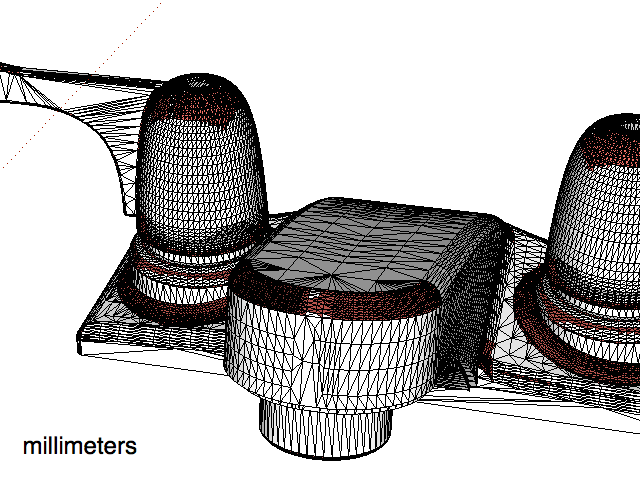 |
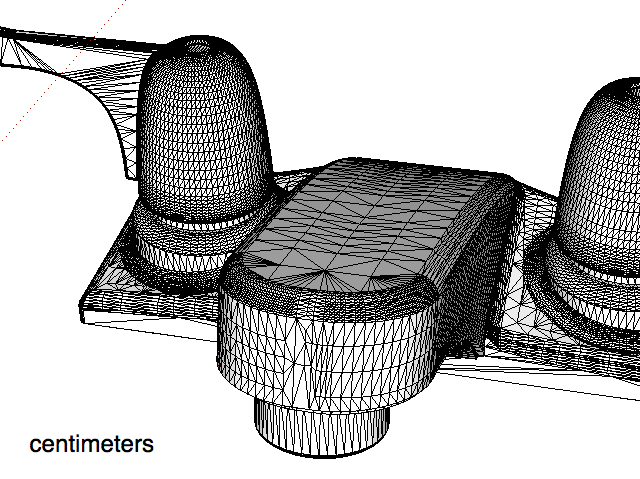 |
After the file import, scale the geometry back down to actual size. To do this, edit into the component and measure a known edge with the Tape Measure tool, and type the correct value for the distance measured. SketchUp will scale all elements within the current context proportionally.
Many CAD files that come from civil engineering programs have their origin points set to a particular world coordinate. Hence, your incoming geometry may be set very far away from the current SketchUp origin, even though there is nothing between the incoming geometry and the ‘world’ origin. You can ensure that the imported geometry is placed at the origin in SketchUp by making sure that the Preserve Drawing Origin box is not checked before starting the import.
Disconnected edges in a CAD fileA CAD file can look okay and yet, for whatever reason, it can have disconnected edges that do not meet exactly endpoint to endpoint. In SketchUp faces are formed by a closed loop of edges that all touch endpoint to endpoint and lie in the same plane. When these CAD lines import into SketchUp, they will still not meet, and hence surfaces cannot be formed from these edges, hence the import will appear to drop faces from the model.
SketchUp’s face finder engine can resolve edges down to 1/1,000 of an inch. However, for models with geometry far from the origin or with large separation of geometry within the model, sometimes faces can drop out during import of a file because the face finder cannot resolve them. This is due to the compounding of floating point number rounding, and hence the endpoints no longer match exactly to form a closed loop.
CAD files sometimes have small edges that hang off a closed loop. These ‘hanging edges’ can cause the SU face finder to fail at creating faces even though there is a closed loop of edges present. For this reason, using CAD lines can be especially problematic.
CAD file layersCAD treats lines separately from one another based upon layering. In SketchUp, all free edges (those not encapsulated in a Group or Component) will merge one with another, regardless of their layer of origin. This can cause confusion during import where lines on different layers cross over one another causing merging and breaking of one another.
A method to help avoid the overlapping issue is to save out multiple CAD files, exporting groups of layers at a time, essentially ‘presorting’ your edges as they come into SU.
Using CAD files for modeling
For all these types of over-modeling explained below, there are methodologies that can help with your speed and efficiency. Inferring and the Paste in Place function are invaluable for a good modeling workflow. See the article SketchUp best practices and applied principles for a good discussion of this method. You should also consider component hierarchy and naming within your models.
The goal is to get your products on 3D Warehouse and expose them to a world of architects and designers. To get everybody on the same page, we have developed a checklist that should help you double-check that you’ve created beautiful, useful, and easy-to-operate 3D Warehouse models. To go with the checklist, we’ve also created an article and a video series that digs deeper into what each item on the checklist means to help you achieve the desired results.
Using 2D CAD lineworkFor all these reasons mentioned in the previous section, it is often desirable to use the 2D CAD linework import as an underlayment to the modeling process. We recommend that you Do not use 2D CAD line work to form faces, use CAD linework to trace over. Using the inference endpoints and midpoints of CAD lines allows you to be very precise while drawing, without merging to the CAD source linework.
Tracing over top of CAD lines allows you to control the minimum size of faces you create. You also control the number of faces used. You can also separate overlapping edges and faces into separate groups or components, keeping their shapes separated. This remodeling allows you to determine layering as the model evolves. Remodeling also insures that your model faces close as you expect them to, hopefully avoiding any open loop problems.
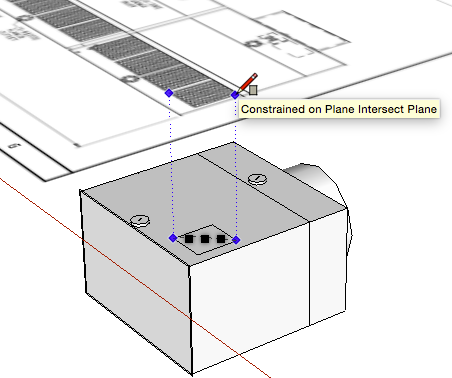 A great use of inferring is when you want to draw from an imported 2D image file to create a 3D object. Here, we hover the rectangle tool over the side of the cooling unit and hold Shift to lock to that plane below. Then draw a rectangle using the CAD image above for the reference points. The points are traced on the CAD image, and the inference lock projects them down onto the face. Entire models can be generated using this method. (also from 2D CAD vector files)
A great use of inferring is when you want to draw from an imported 2D image file to create a 3D object. Here, we hover the rectangle tool over the side of the cooling unit and hold Shift to lock to that plane below. Then draw a rectangle using the CAD image above for the reference points. The points are traced on the CAD image, and the inference lock projects them down onto the face. Entire models can be generated using this method. (also from 2D CAD vector files)Source CAD files that are 3D already contain surfaces, and they come into SU as faces. If you choose to use the 3D CAD geometry as SU model geometry, you will need to pay particular attention to the layers coming in from CAD, and the component naming and nesting coming in from CAD. Usually 3D CAD files do not suffer from hanging edges, but they do tend to have very dense geometry (lots of faces) and can have missing faces due to the math rounding issues discussed above.
 |
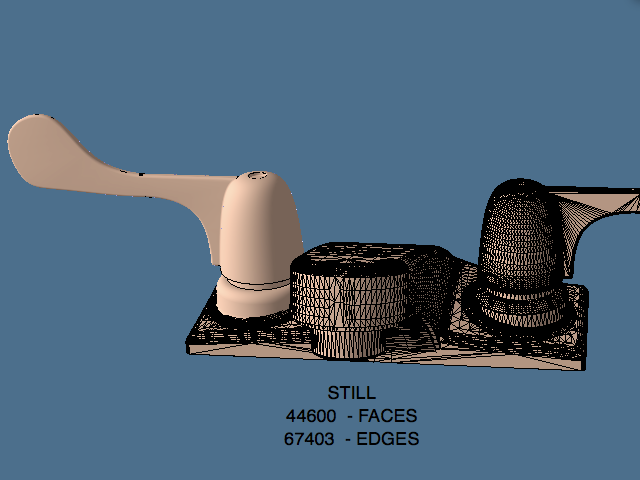 |
SketchUp has the ability to hide triangle (face) edges in a unique way, such that the face and all adjacent faces that share its edges are treated as one continuous “smooth” surface. Using smooth edges on a high poly model transforms it from a blackened image to a soft shaded model. But the heavy polygon count remains.
 |
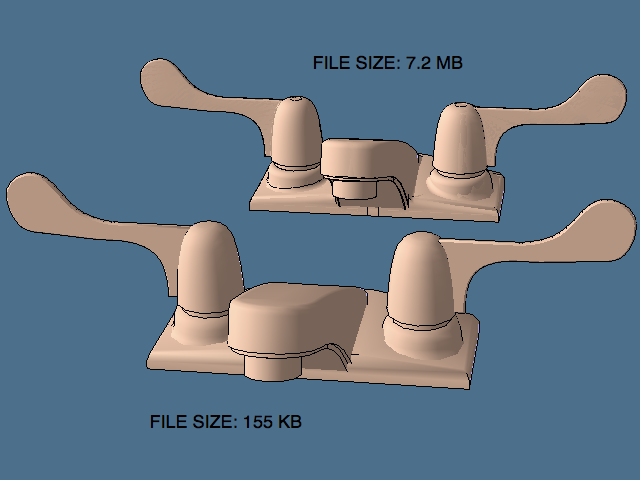 |
The polygon count (number of faces) affects the product component file size. In turn, this affects the performance of any SketchUp model into which it is placed. In this example, a bathroom design involving 10 faucets would add 7.3 Megabytes to the overall design file for just the faucets, whereas using a reduced poly version would only increase the design file size by 228 Kb. It does not take long for high poly count product files to make an AEC building design file sluggish, large, and unworkable.
Model optimization of 3D CAD files
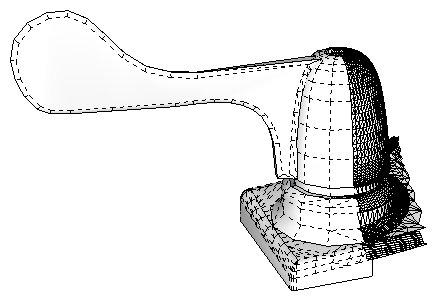 For the model optimization workflow, you replace complex geometry with optimized geometry, thus decreasing the polygon count and hence file size. The goal here is to simplify the model geometry, while still representing the product accurately. Many CAD generated 3D models represent surfaces very accurately with very dense geometry. A small radius can get the same triangulation as a larger curve. Good 3D Warehouse models do not require this level of detail.
For the model optimization workflow, you replace complex geometry with optimized geometry, thus decreasing the polygon count and hence file size. The goal here is to simplify the model geometry, while still representing the product accurately. Many CAD generated 3D models represent surfaces very accurately with very dense geometry. A small radius can get the same triangulation as a larger curve. Good 3D Warehouse models do not require this level of detail.
Here is a video series showing the optimization of a faucet fixture.
Within this series, several advanced optimization methods are explored. The method you use is based upon the nature of the object being modeled. So to develop one product model ( eg a faucet) you may use several modeling methods, one for the handle, another for the spout, etc. The faucet series linked above shows the following methods: the Push/Pull Scale & Rotate method, Align axes & Scale method, Profile & Follow Me method, Merge Surfaces with Move Tool method, Offset chamfer method, Perimeter Profile Modeling method, and the Push/Pull & modify profile method.
Automating polygon reduction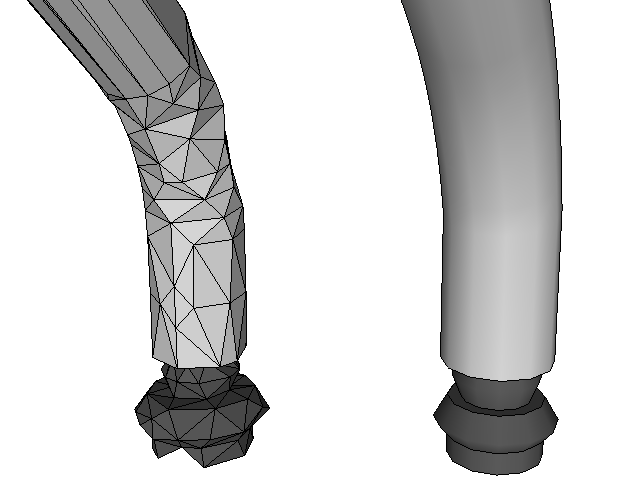 Poly reduction (sometimes referred to as decimation or re-sampling) is very often required when moving from engineering based 3D CAD geometry into SketchUp. There are several software programs which automate poly reduction to one degree or another. The trick is to have the simplified object still appear as close to the original as possible in detail and outline. For most hard edge type models where members are a specific diameter or curvature, automatic decimation degrades the exact nature of the hard edge elements, causing tubes to become serrated, and hard edges to become rounded.
Poly reduction (sometimes referred to as decimation or re-sampling) is very often required when moving from engineering based 3D CAD geometry into SketchUp. There are several software programs which automate poly reduction to one degree or another. The trick is to have the simplified object still appear as close to the original as possible in detail and outline. For most hard edge type models where members are a specific diameter or curvature, automatic decimation degrades the exact nature of the hard edge elements, causing tubes to become serrated, and hard edges to become rounded.
It is recommended that you model over top of 3D CAD generated geometry, rather than using the original CAD linework for a 3D Warehouse component. Optimizing a model directly with SketchUp modeling creates a very clean and tight model, minimizing poly count and maximizing approximation of the bounds of the original product, because you are snapping to exact points on the original polygons.
In the faucet example shown above, the new faucet geometry was modeled directly over the original CAD linework, which was File > Imported and made into a group first. The CAD linework was used as a reference when aligning new geometry and push/ pull, move, and scale operations to each other. This allows the modeler to be accurate to the physical dimensions and constraints of the actual product.
See the article: Making a detailed model in a lightweight way for best practices in SketchUp over modeling. The video Importing CAD files into SketchUp discusses the different types of CAD that can be brought into SketchUp.
Polygon reduction softwareOne handy tool for reducing polygon count is the MeshWrapper, which wraps a regular mesh grid around the outside of a selection of object(s). This is useful for simplifying organic products prior to poly decimation because it distributes an even set of points across the selection. Another handy surfacing tool driven by paths and profiles is Curviloft or here and here.
Engineering CAD files can be simplified prior to import into SketchUp using polygon decimation software such as PolyTrans from Okino Computer Graphics and Simplygon Cloud https://www.simplygon.com/ , and MeshLabs from SourceForge which is an open source project. An efficient workflow is to use a combination of automatic poly reduction and SketchUp modeling.
